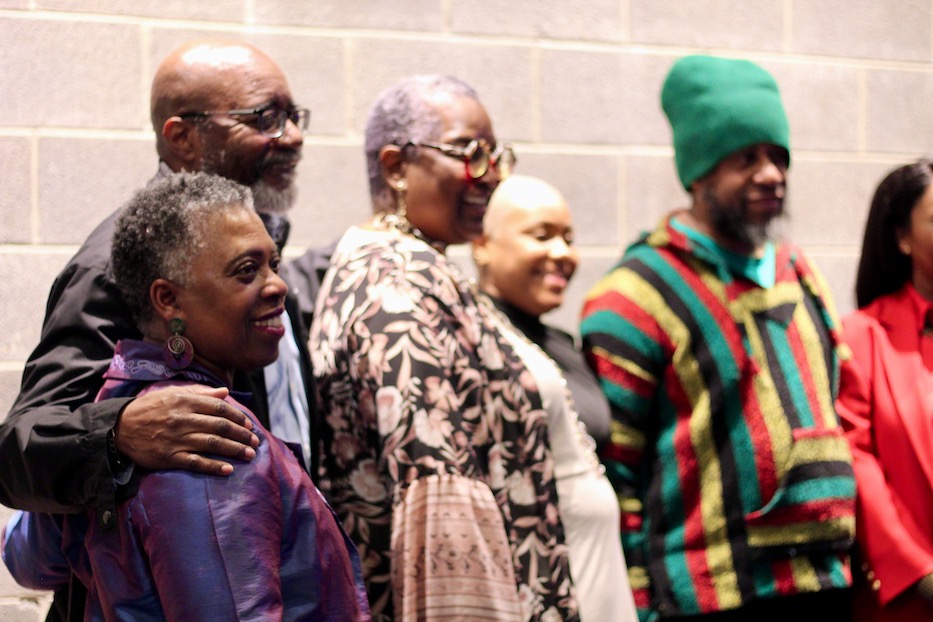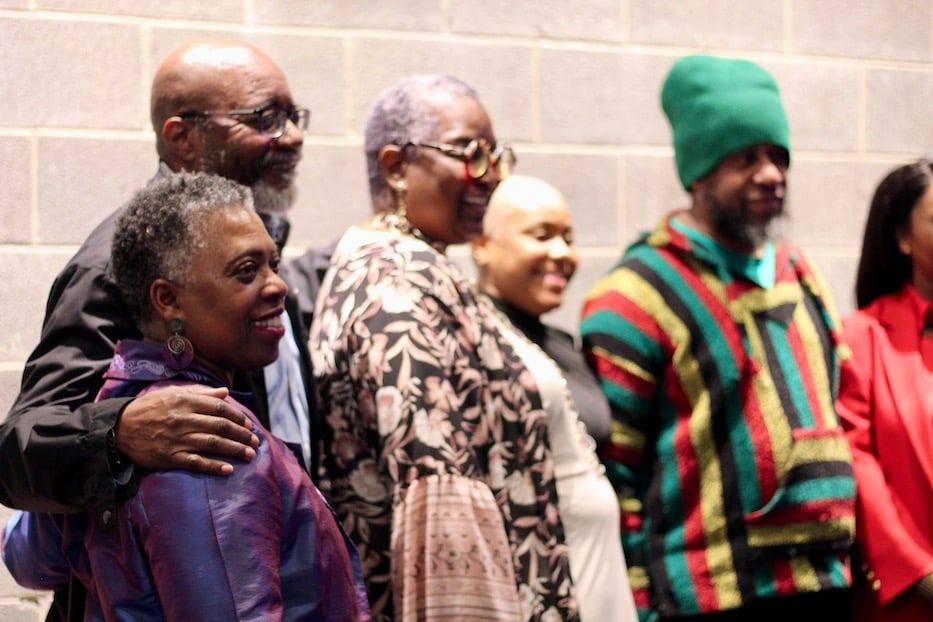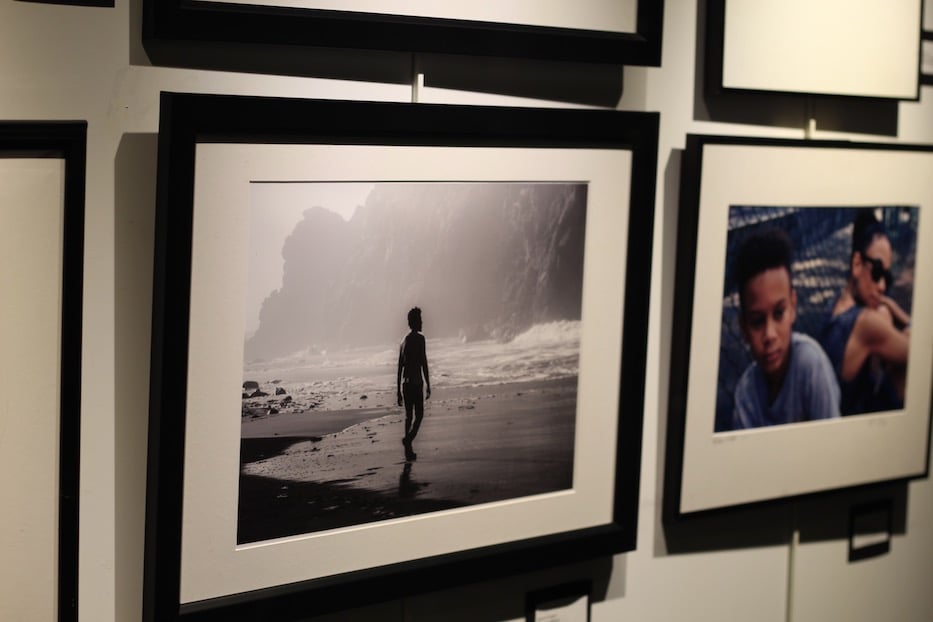
Culture & Community | Photography | Arts & Culture | WNHH | Film & Video | Arts & Anti-racism

Photographer and filmmaker Lydia Douglas (at left, in the purple) at an opening reception for Seven Lenses at SCSU last month. Lucy Gellman File Photo.
A mother runs her daughter’s hair gently through her palms, her hands a sudsy ballet. The little girl leans back, completely at peace. Her shoulders gleam. Her eyes close; there’s just the hint of a smile in her still-baby cheeks. It’s just bath time, but the moment feels holy. A singing drumbeat hammers steadily away beneath the frame.
The scene is part of Nappy, a graduate thesis film from photographer and filmmaker Lydia Douglas that turns 25 this year. From now through the end of March, her exhibition How I See Us runs at the Kellogg Environmental Center in Derby at 500 Hawthorne Ave. For the artist, who also took part in Seven Lenses at Southern Connecticut State University and a celebration of Black hair at ConnCORP earlier this year, it’s part of how her work continues to evolve decades in.
“What I’m doing is capturing us,” she said in an interview on WNHH Community Radio’s “Arts Respond,” a collaboration between WNHH and the Arts Paper. “Most of my subjects are Black people … Black people in the diaspora. I see beauty in us that I don’t know that a lot of people see. And what I want to do is convey what I see and feel when I’m looking at a Black person.”
Initially, Douglas didn’t intend to be a photographer. While her late father was an artist and “I was always interested in photography,” including documenting her family at gatherings, Douglas’ gravitated initially toward fashion design. In high school, she became skilled at making her own clothes, and dreamed of what a career in design might look like. So when she enrolled at the University of New Haven, the discipline seemed like a natural fit.
But at UNH, she realized she didn’t like drawing—the practice of which is necessary for fashion design. She also wasn’t thrilled about taking studio art classes. On a whim, she slipped a photography class into her schedule, with every intention of going back to painting and studio art. She credits her late friend, fellow UNH alum Alan Lewis, with seeing and fostering her love for the camera and the darkroom.
She never went back to that painting class. She fell in love with the nuance and delicacy of film photography instead. She loved everything about it, she said: the alchemy and quiet of the darkroom, the precision of choosing the right moment, the wait before knowing exactly how a photo would turn out.
“I picked up the camera and I never put it down,” she remembered. By the end of her time at UNH, she was known for her deeply human, often very intimate photographs of Black siblings, parents, families, and friends living their lives. In her work, she found a calling to depict Black people in a way that she didn’t see journalists—most of them white—doing in the mass media. The images are meant to speak to the deep, complex humanity of her subjects.
There’s a print she returns to, for instance, of her late brother with his then-infant daughter lying on his chest. It’s a gentle, fleeting moment, the two enmeshed in a time-limited tableau. In a few years, she will be too old to lay there, sweetly drifting between sleep and wakfulness. And then in a few more, he will be gone. The shutter clicks. She manages to freeze that warmth between them.
“When people look at that, I want them to see the softness in my brother,” she said. “I want them to see the connection between the two of them. I want them to see how the baby trusts him, and how comfortable she is with him. Because there are so many pictures in the media … they don’t always capture us as we really are. Those tender moments aren’t there.”
From photography, she said, film seemed like the logical next step because it would reach more people. In the 1990s, she enrolled in the graduate program in cinematography at Howard University. Nappy grew out of a thesis proposal focused on Black women and girls, and inspired partly by her photo series Sista Sista. The series contrasts Douglas' work with depictions of Black women in the media, showing how a white gaze nearly always reduces them to stereotype.
As she crafted the documentary, she was interested in women who were choosing to wear their hair natural, sometimes for the first time since very early childhood. There was something necessary and exhilarating in the pushback against a European standard of beauty, she said—it had never spoken to her lived experience, and was never meant for Black women. Instead, the idea that straight, frizz- and volume-free
“When Black women wear their hair natural, it is a political statement,” she said. “Even though we may not consciously say, ‘I’m trying to make a political statement, I’m gonna shave my head,’ [if] you do it, it’s a political statement because you’re going up against the status quo.”
 Robert Cooper's image of Tarishi Shuler photographed on Pfeiffer Beach in Big Sur, California, with Lydia Douglas' "Lauren and Jordan," in Seven Lenses. Lucy Gellman File Photo.
Robert Cooper's image of Tarishi Shuler photographed on Pfeiffer Beach in Big Sur, California, with Lydia Douglas' "Lauren and Jordan," in Seven Lenses. Lucy Gellman File Photo.
It was personal too. Douglas grew up with her mom using a hot comb, and later fought with her about natural hair. If she went to church over the weekend as a kid, she had to straighten it first. When she tried to learn how to swim, she found that swim caps had never been made with Black women in mind. She was 19 years old when she shaved her hair off for the first time.
To find participants, she placed a classified ad in the Washington City Paper, an alt weekly that has since survived in digital form. In particular, she said, she specified that women and girls “had to wear their hair natural as a commitment,” she said. That meant no chemical treatments, no hot combs, no flat irons, no blow dryers. In the film, there is only one exception, a mother who blow-drys her daughter’s hair before braiding it.
As women responded, the project became collaborative, Douglas remembered. Mothers brought along their young children. Subjects in the film recommended their friends. People made music suggestions. At one point early on, almost a dozen women sat together around a table talking about their choice to go natural. What started as a single thesis idea became an entire community.
“It was this really amazing community of Black women that wanted to get this project done,” she said. Within it, she credits some of her own family members, including her aunt Lily and late father.
Following the film, she stayed in touch with a few of the women, including an aunt of hers who lives in Connecticut and has long worn her hair natural. Subject Zakiya Carr, who Douglas documents as she has her head shaved, has become a champion of the film in her own work on Afro-Latinidad. She is currently working to get the film translated into Spanish, she said.
Two and a half decades later, she’s struck by how relevant the film still feels. In the United States, the C.R.O.W.N. (Creating a Respectful and Open World for Natural Hair) Act, barring discrimination against natural hair, only became a movement in 2019, and came to Connecticut two years ago. She closely follows the growing number of lawsuits that point to a link between hair relaxer and certain reproductive cancers. And when she looks around, she said, she still sees an overwhelming bent towards relaxed styles over natural hair.
“We’ve internalized this thing about hating our natural hair,” she said. “Our aunts, our moms, our family members, even some Black men. And then we get discriminated against from the outside community.”
She is also still very moved by the subject, Douglas said—and intends to build on it. Currently, she’s raising funds for a national HBCU and community tour of Nappy, a screening and fundraiser for which took place last Sunday at the Kellogg Environmental Center. In New Haven, she said, locations for the film might include an event at the Dixwell Community Q House or Stetson Branch Library.
She also doesn’t see the subject as done, she said. She still wants to use photography and film to tell the hairstories of Black women and alopecia, Afro-Latinidad, Black men’s feelings on Black women’s hair, and documentary filmmaking on the African continent. A quarter of a century after the film first made its debut, she said, the ideas are still coming.
“When it [the film] first came out, like the first 10 or 15 years, I was very very excited about it,” she said. “So now, I just have to keep that excitement up by constantly showing the work. Making new work, showing it in different places, and just being out there in the public.”
To listen to Lydia Douglas on WNHH’s “Arts Respond,” click on or download the audio above. Her exhibition How I See Us runs at the Kellogg Environmental Center in Derby at 500 Hawthorne Ave. through the end of the month. To get in touch with her, email pzhead2@gmail.com. You can also follow her at @pzhead on Instagram or on Facebook.

